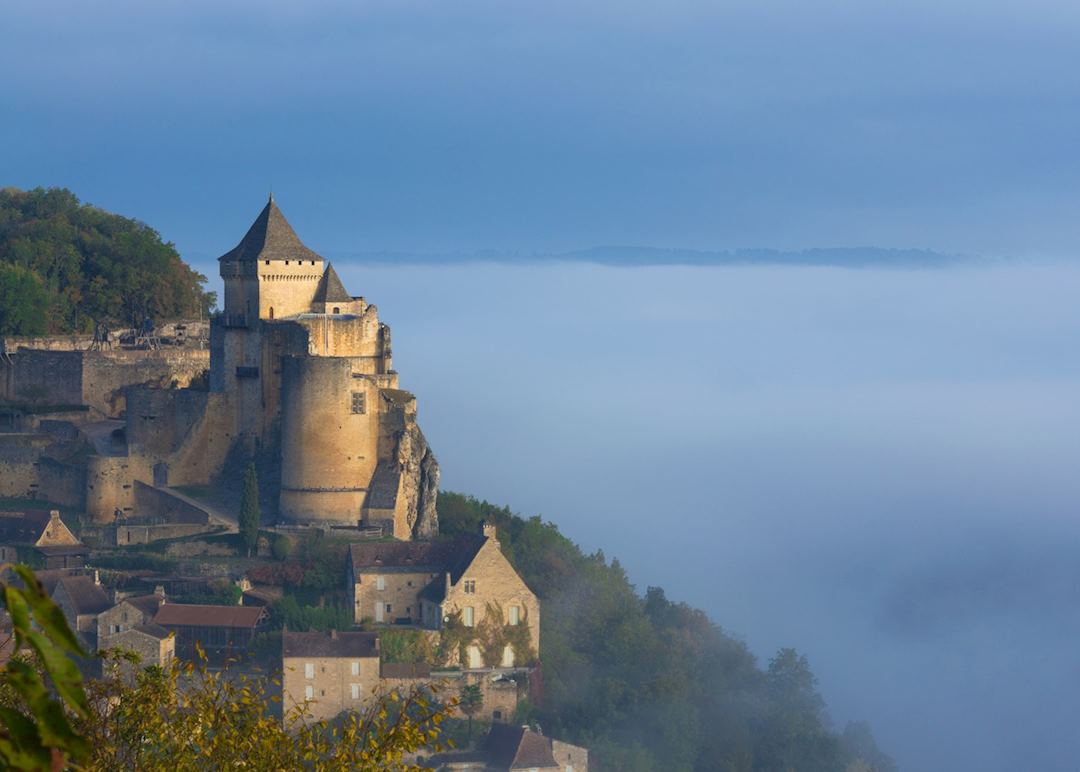Sitting at the confluence of the Dordogne and Céou rivers, Castelnaud-la-Chapelle is a medieval town of narrow lanes, stone cottages and ramshackle old buildings. It sat at the boundary of the French and English territories during the Hundred Years War and is dominated by its 12th-century fortress, Château de Castelnaud, which squats on a clifftop above the town. Steep streets lead to the lofty castle from where you’ll get sweeping views of the surrounding countryside.
Château de Castelnaud was founded in the 12th century, and was attacked and changed hands on numerous occasions in the following years. During the Hundred Years War the castle owners remained largely loyal to the Plantagenets and Château de Castelnaud became known as the ‘English Castle’. Today, its massive ramparts are just as imposing with additional works over the years offering an insight into French castle history and the evolution of fortifications during the Middle Ages.
In 1442, the King of France ordered a siege of the castle and when it was recaptured he returned it to the Caumont family, its owners since 1368. New defences were added including a barbican, drawbridge and artillery tower, as well as new living quarters. In the 17th and 18th centuries the Caumonts were a powerful dynasty but they preferred to spend their time elsewhere and Castelnaud fell into disrepair. By the time of the French Revolution the fortress was abandoned and was later used as a stone quarry and as a shelter for Resistance fighters during World War II.
Rescued by Philippe and Véronique Rossillon in 1965, it’s now fully restored. You can tour the guard room and artillery tower, the keep and kitchen, as well as the raised walkway behind the ramparts. Within the 15 m (50 ft) high walls is the protected upper courtyard with its medieval covered well.
Inside, the grand rooms house a Museum of Medieval Warfare with a collection of more than 230 weapons and even some instruments of torture from all over Europe. Along with displays of swords and crossbows of every description, you can see chainmail, daggers, pronged clubs and hammers, and, on the battlements outside, full-scale reconstructions of powerful siege engines such as bombards, trebuchets, mangonels and an organ gun. Archery and catapult demonstrations take place daily and films and interactive screens bring the displays to life.
More sedate is the medieval garden which has recently been added to the estate. From the upper bailey and terraces you can get sweeping views of the Dordogne River in one direction and the Céou Valley in another, taking in La Roque-Gageac and the castle’s arch-adversary, Château de Beynac which lies on the opposite bank of the river 4 km (2.5 miles) downstream.
Steep lanes lead down from the castle to the town and riverbanks. The stone houses here are built in typical local style with steep roofs, wooden shutters and arched gateways. Many are half-timbered or draped in vines and roses adding to the village’s atmosphere. The riverbank makes a good spot for a picnic in summer, or there are a range of caf茅s and restaurants to choose from.
Best time to visit Castelnaud-la-Chapelle
The castle is open year round but is at its best between April and October when the sweeping views of the river valley are most impressive. From mid-July to August medieval displays and mock battles take place during the day with additional theatrical performances each evening. River cruises and canoe trips are also possible in the summer months.
who's been there
Start planning your tailor-made trip to Castelnaud-la-Chapelle by contacting one of our France specialists
-
01993 838 92501993 838 925
- Make an enquiry
Places near Castelnaud-la-Chapelle
- Beynac-et-Cazenac less than 5 miles away
- La Roque-Gageac less than 5 miles away
- 厂补谤濒补迟-濒补-颁补苍茅诲补 7 miles away
- Dordogne 44 miles away
- 厂补颈苍迟-脡尘颈濒颈辞苍 64 miles away
- Bordeaux 85 miles away
- Biarritz 163 miles away
- Chinon 169 miles away
- 鲍锄猫蝉 172 miles away
- Ch芒teau d'Azay-le-Rideau 173 miles away
- Ch芒teau de Chenonceau 174 miles away
- Ch芒teau de Villandry 178 miles away
- Pont-du-Gard 179 miles away
- Amboise 181 miles away
- Ch芒teau de Chaumont-sur-Loire 185 miles away
- Ch芒teau de Cheverny 187 miles away
- Orange 187 miles away
- Ch芒teauneuf-du-Pape wine region 190 miles away
- The Loire Valley 190 miles away
- Arles 190 miles away
- Avignon 191 miles away
- Lyon 192 miles away
- Ch芒teau de Chambord 195 miles away
- Les-Baux-de-Provence 196 miles away
- 厂补颈苍迟-搁茅尘测-诲别-笔谤辞惫别苍肠别 197 miles away
- L'Isle-sur-la-Sorgue 204 miles away
- Gordes 211 miles away
- 搁丑么苍别-础濒辫别蝉 213 miles away
- 惭茅苍别谤产别蝉 213 miles away
- Roussillon 215 miles away
- Aix-en-Provence 232 miles away
- Annecy 254 miles away
- Provence 257 miles away
- Talloires 257 miles away
- Normandy 286 miles away
- Paris 286 miles away
- Chamonix 288 miles away
- Mont Saint-Michel 293 miles away
- Saint-Tropez 294 miles away
- The French Riviera 294 miles away
- Grasse 298 miles away


